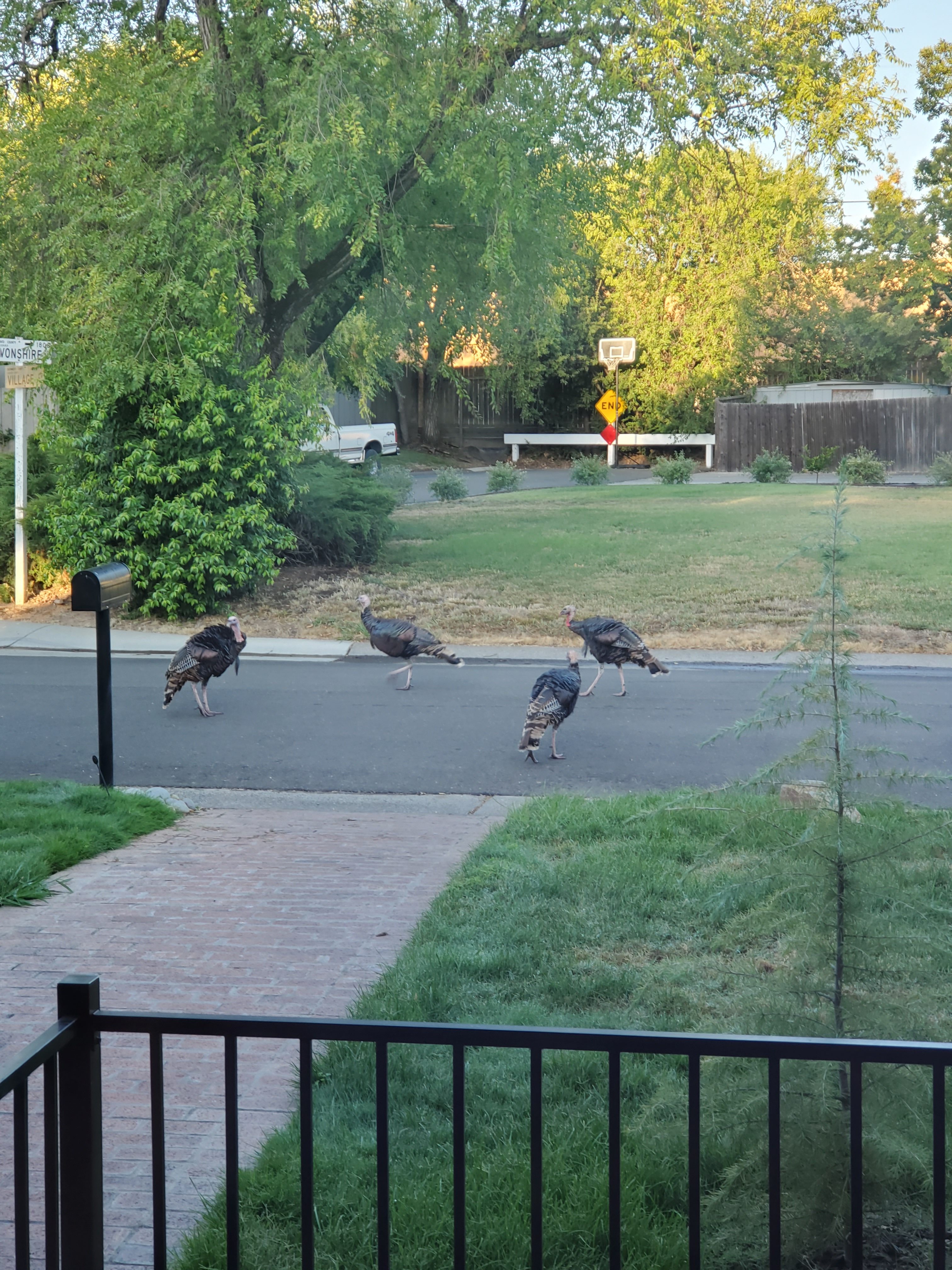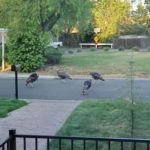Since my last blogpost, we have made a lot of changes. In June, the whole family including Patrick and myself, the three “kids” (the girls are 22 and 19, but still) and our 2 dogs moved to California. I started a new job as Chair of Psychiatry at University of California Davis. We have a new house that came complete with a feral cat from the last owners. Our new cat, whom we have named Muffin, comes as regular as clockwork to the porch at 6 pm. He waits for his dinner, and then hangs out for another hour or so, luxuriating on the warm bricks.
As scheduled as Muffin’s dinnertime, we also have a group of 10-15 wild turkeys that saunter through the neighborhood in the morning, and then, again in the evening, in 12 hour cycle. Early yesterday morning, I went out to given Muffin some fresh filtered cool water (only the best for my feral cat) and saw something different going on with these birds.
Most of the turkeys were ambling around our neighbor’s lawn like usual, but two of them were off to the side fighting. Not a little skirmish, but a prolonged battle, pecking the hell out of each other’s faces and necks. Every few minutes, one turkey would wrap his neck around the other’s and try to take him down. Like Turkey Wrestlemania.
At first, I found it funny and Instagrammed a boomerang video making up a caption about the turkey version of West Side Story’s Jets and Sharks. But when it didn’t stop after 10 minutes, I started to find it disturbing and stood in the middle of the street telling them to cut it out. Finding that ineffectual (they didn’t even look up), I ran back to the porch and got the garden hose out to try to separate them. Sadly, my hose stream didn’t reach across the street to stop the pummeling poultry.
Next, I ran into the house to wake up the only other person there, 19 year old Sophia. She was fast asleep because her college class didn’t start until later. I yelled “Wake up! I need your help with 2 turkeys who are fighting!” She just blinked at me, seemingly not comprehending what I was saying. Concerned that she was missing the gravity of the situation, I just kept repeating my plea louder and more slowly, to which she replied “Isn’t there someone more responsible than me at home?” I told her no, that Patrick was dropping Theo off at school, and I needed her help asap before there was turkey blood on my hands.
Sophia stumbled outside, blinking in the sunlight like a hibernating bear who had been disturbed. I turned back to her and cried “Sophia! Google ‘how do you separate 2 turkeys who are fighting?’!” She took one look at the scene and said in her inimitable deadpan “Just let them work it out”, and went back into the house to climb back into bed.
A minute later, Patrick drove up. He had the gall to tell me with the absolutely fascinated voice of someone who grew up watching Mutual of Omaha’s Wild Kingdom, “Did you see those two turkeys fighting for dominance?”. I recounted all my efforts to stop the fracas, and he laughed so hard that I thought he would pee his pants. He gave me a comforting hug and said: “This is normal turkey behavior. They HAVE to do this to establish order in the group. Once they are done, they will just go on to their business as usual. No turkey is going to die.”[To give you a feel for Patrick’s incredible fund of wildlife knowledge, he informed me (kind of haughtily I must say) on reading this blogpost that a group of turkeys is called a “rafter”. Eye roll.]
It hit me pretty quickly that he was right. While it took about another hour, eventually the two turkeys did just move on. I thought about the turkey throw down the whole way to work, and how uncomfortable I was with their conflict. Ironically, a lot of my new job is about handling conflict. Like the wild turkeys, after 20 years in academia, conflict is just an everyday occurrence, and getting through it is part and parcel of my day.

Turkey détente established
With my faculty, I sometimes perceive that they feel avoidant of conflict. Because I am the new Chair, conflict avoidance might occur because they fear getting on “my bad side” too soon. Maybe they don’t get out a “hose” to make it stop (totally ridiculous, I admit it now), but they might try to dodge it at all costs. Rather, I want faculty to know that they can disagree with me and I don’t view it as a bad thing. An exchange of ideas will ultimately help me to make better decisions. Leaders should welcome opposing views rather than find them a threat.
In conflicts of other kinds such as with colleagues in other Departments, there may be a fear of being unlikeable, or being perceived as disagreeable (or a “bitch” if one is a woman). It could also be the worry about hurting or losing a collegial relationship. In truth, good people can disagree about an issue and still have a good relationship. I stopped worrying about being universally liked a long time ago. As an aside, I will say it was a pleasant surprise when another Chair told me in a meeting this week that I was “a breath of fresh air” (maybe because I am used to thinking of myself as “100% that bitch” to paraphrase Lizzo). Of course, the other Chair and I have not been in conflict yet, so the phrase he uses to describe me might change if a conflict arises.
Conflict drives compromise. On one occasion this week, a faculty member and I disagreed and later, we each independently emailed each other that in thinking about it more, we agreed with some of what the other had said. Conflict resolution is a process; Sometimes for the sake of expedience, we might try to resolve conflict prematurely, but if we have the luxury of a bit of time, giving each person the time to process the conversation and think about alternative views brings better results.
To be fair, in a departure from our battling turkeys, managing conflict should never be about mistreatment, aggression, raised voices, insults/making things personal or shows of dominance. Rather, it should be in the context of being present (ideally in person) and listening to others’ points. Conflict over email rarely goes well.
So, yes, I was a bit ridiculous yesterday in handling the neighborhood turkey clash, but in the end, as one of my med school lab partners always said, “at least it makes a good story”. And my kids will have another great “mom story” to pass on to their kids.






